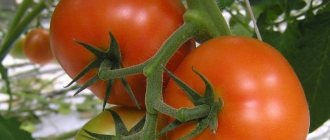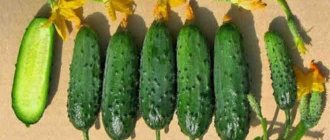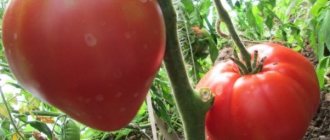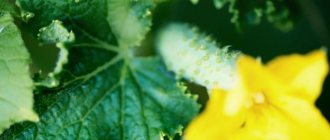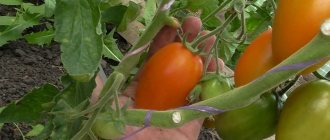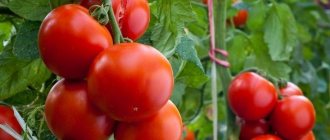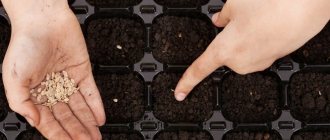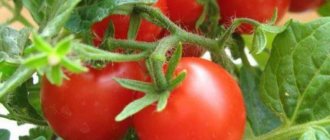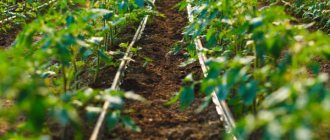Description of tomato variety General
Tomato General F1 is a hybrid that came from crossing several varieties and combines their best qualities. The culture is intended for cultivation in open ground in the southern regions and under protective materials in colder regions. Has early fruiting periods.
The fruits are distinguished by high commercial qualities - beautiful appearance and uniformity throughout the plant
The General tomato bush forms a determinate type, which means low growth and its independent completion. The plant reaches no more than 1 m in height, has average growth vigor and a well-developed root system. The top ends with a flower brush. The plant is stress-resistant, with high fruit set.
The leaves are medium to large in size and dark green in color. The foliage is good. With a small bush, the General F1 hybrid is highly productive.
The culture is suitable for regions with a high background of diseases, because it has intermediate resistance to some viruses and high immunity to fungal infections. Due to the excellent quality of the products, the hybrid is grown not only on personal plots, but also on farms for subsequent sale. The yield of marketable products is 93%.
Description of fruits
The fruits of the General F1 tomato are large, leveled, round-flat in shape. The weight of one tomato is 220-260 g. When ripe, they have a rich red color. During the period of ripeness, they are colored evenly both on the surface and inside. There is no green spot on the stalk.
Tomatoes are multi-chambered, but seeds for reproduction are not collected independently; they are obtained through complex breeding work
The fruits have good density, do not crack, have a long shelf life and are suitable for transportation. The tomatoes taste great. The juice contains 5-6.6% dry matter and 2.4-4.5% total sugar.
Taste of fruits
General tomatoes are mid-early tomato varieties that begin to ripen in late July or early August. Ripe fruits have a round, slightly flattened shape and a bright red color. The smooth skin does not crack, which allows tomatoes to be stored and transported. That is, this variety is suitable for growing not only for your family, but also for sale.
The pulp of tomatoes is dense and tasty. The weight of each fruit reaches 200-270 g. Each cluster bears 8-12 fruits.
Characteristics of the General tomato
Tomato General F1 is an early ripening hybrid with beautiful bright red fruits. The low-growing bush is recommended for growing in open ground. The crop is high-yielding, 5-6 fruits grow on one cluster. Tomato has been bred with high immunity to diseases. The plant is responsive to fertilizing with mineral fertilizers.
Productivity and fruiting
The compact tomato bush General F1 has high productivity. In open ground, under favorable growing conditions, it brings from 20 kg of tomatoes per 1 sq. m. m. It begins to bear fruit in the second month from the start of cultivation.
Area of application of fruits
The high keeping quality of General tomatoes allows them to be used for a long time for preparing fresh salads. The fruits are also used for various processing. But the large size of tomatoes is not suitable for whole-fruit harvesting.
Resistance to diseases and pests
Thanks to breeding work, the General hybrid has received high resistance to various diseases.
Tomato has high resistance to:
- Alternaria;
- fusarium;
- verticillium;
- gray leaf spot.
Differs in intermediate resistance to viruses:
- bronzeness of tomato;
- yellow leaf curl.
Such characteristics are indispensable for growing crops in areas with a high risk of infection. But if plants are resistant to the listed diseases, they must be treated against late blight.
Planting “General” tomato seedlings in the ground
The place to place tomatoes on the site should be in good sunlight. The best soils for them are sandy loam or loamy soils. When digging, you need to add 150 grams of complete mineral fertilizer per 1 square meter. meter. Important! It is necessary to ensure that no potatoes, peppers, physalis, or eggplants grow on the site in the last three years.
The best predecessors for tomatoes are beans, peas, and zucchini. In the bed prepared for planting, you need to fill holes. This can be done with a flat cutter or a hoe. The depth of the holes should be about 15 cm. The distance between them is 0.3 - 0.4 m. It is most convenient to plant tomatoes in two rows. The distance between them is left at 0.4 - 0.5 meters.
Pros and cons of the variety
Tomato General is a crop with fruits of high commercial quality, excellent shelf life and transportability.
pros
- large fruit;
- amicable maturation;
- low bush;
- suitable for growing in open ground;
- uniform coloring of fruits inside and outside without contrasting spots;
- dense, non-cracking tomatoes;
- heat-resistant bush, good fruit set at elevated air temperatures;
- high yield.
Minuses
- impossibility of collecting seeds.
Tomatoes have excellent taste and early ripening
For sowing, you need to buy new seed material each time. It is distributed by the following companies:
- "Sakata";
- "Gardens of Asia";
- "Agromarket".
The crop has passed variety testing in Russia and is officially approved for cultivation.
How to get tomato seedlings “General”
Like all early tomatoes for open ground, this variety is grown through seedlings in regions with temperate climates. In the southern regions it can be sown directly into the ground.
Sowing time for seedlings
Considering that the time for planting early tomatoes in open ground occurs in most regions only at the very end of May, they should be sown for seedlings between March 15 and March 20. Shoots will appear after a week, and by the time of transplantation the seedlings will have reached the desired age and size. In regions with late frosts, seedlings can be sown in the first week of April.
Sowing seedlings
If the seedlings are intended to grow tomatoes for sale, the seeds can be sown in boxes or seedling trays. For an amateur garden, you can use individual seedling cups with a capacity of 0.4 - 0.5 liters.
The selected containers are filled with earth. To do this, you can buy ready-made soil for crops from the Solanaceae family. You can make the mixture yourself, for this you need to take the following components:
- one part of garden land
- one part of humus
- a glass of wood ash per 10 kg of soil
After the seedling boxes or cups are filled with soil, water it well and plant the seeds at a depth of no more than 0.4 - 0.5 cm into the soil. The containers are covered with glass or film and placed in a warm room in a bright place. After germination, the glass is removed.
At the stage of three or four true leaves, the seedlings are plucked, and with the onset of warm weather they are transplanted into open ground. Before transplanting, the seedlings are hardened off 8-9 days before transplanting. To do this, in warm weather it is taken out into the open air for several minutes, gradually lengthening the period of stay in it to several hours. After watering the seedlings generously 48 hours before planting in the ground, they are no longer watered.
Video about sowing tomato seeds for seedlings:
Features of cultivation
The General tomato is grown in seedlings, less often sown directly into the ground. The seeds are treated with a fungicide and their pre-sowing preparation is not carried out. Sowing begins 45 days before transplanting into ridges. In the southern regions, seedlings with several developed leaves can be planted directly into open ground. Therefore, the sowing date is chosen based on the climate of the region and growing conditions.
The planting container can be common, pre-treated with a disinfectant. The soil needs to be fertile and loose. Both purchased and garden soil are pre-disinfected with fungicides. Before sowing, the soil is moistened, shallow grooves are marked, and dry seeds are placed in them at intervals of 2 cm. A small layer of soil is poured on top and pressed lightly.
Germination time is about five days; during this period, the crops are kept at a temperature of +25°C. They also monitor soil moisture and water the seedlings using irrigation through a fine spray bottle. After the seeds hatch, they are moved closer to an intense light source.
Grown plants are transferred to open ground. The soil on the site should warm up to +15°C to the entire depth of the hole. The soil is preliminarily limed and filled with mineral fertilizers. The holes are placed so that per 1 sq. m had 3-4 plants.
Planting holes are dug to the size of the earthen ball and watered abundantly. The plants are placed vertically in the hole, at the same soil level as they grew during the seedling period. Cover with previously removed soil and lightly press it down.
Advice! After planting, plants are shaded and not watered for a week, which allows them to strengthen the root system.
Low-growing tomatoes also need to be tied up; for this, stakes are installed next to the bushes or the stem is tied with twine to a trellis.
The low growth type of the bush allows compact placement of tomatoes on the site
A General tomato is formed into several stems, the remaining stepsons are removed as they appear. The leaf apparatus is reduced slowly, removing several leaves per week and only under the cluster, on which the fruiting has already begun.
Important! The first fertilizing is applied a few weeks after the bushes adapt to the new location and begin to grow.
At the beginning of the growing season, nitrogen-phosphorus fertilizers are used, later - phosphorus-potassium fertilizers. In addition, plants need microelements such as boron, magnesium and calcium. Fertilizers are applied to the root zone or sprayed over the leaves.
To protect the soil from overheating, apply a mulching layer of dry mown grass or dark covering material. This method also allows you to retain moisture in the soil longer and creates the right microclimate.
Soil and seed preparation
Direct planting of seeds in prepared soil can be done in one or separate containers. The soil is watered with a solution of potassium permanganate in order to avoid the appearance of blackleg. The solution should have a dark pink color. A film is stretched on top, which creates a steaming effect.
Experienced gardeners recommend freezing the soil a little before planting. This will rid it of pest larvae.
Tomato seeds are most often already processed and ready for planting. For prevention, you can wash them in a weak solution of potassium permanganate or boric acid. After this, without fail, rinse in warm, clean water and dry.
After the soil has cooled to normal temperature, we mulch it with peat and begin planting. The depth of immersion in the soil should not exceed 0.5-0.7 centimeters. If you decide to germinate seeds in one container, the distance between the holes should be at least 1 centimeter. After planting the seeds, the container is covered with film and stored in a well-lit place without drafts.
For the first 5-7 days, seedlings are stored at a temperature of 15-16 degrees. Then the temperature rises to 20-22 degrees.
Disease resistance and processing
An important characteristic of the variety is disease resistance. It does not suffer from tomato tobacco mosaic virus, is resistant to tomato bronzing, Alternaria, gray spot, fusarium rash, yellow leaf curl virus, and is resistant to spotted and verticillium wilt virus.
Tomatoes become more resistant to fungal infections if mineral fertilizers containing potassium, magnesium, and nitrogen salts are used.
You can use folk remedies to achieve a better tomato harvest: wood ash (either a solution or simply dusting the soil under the bushes), bird droppings or mullein (a solution for wet feeding).
